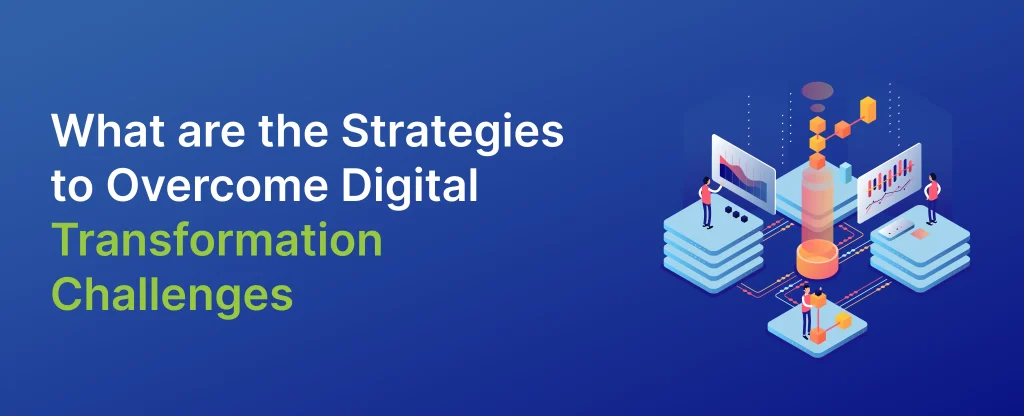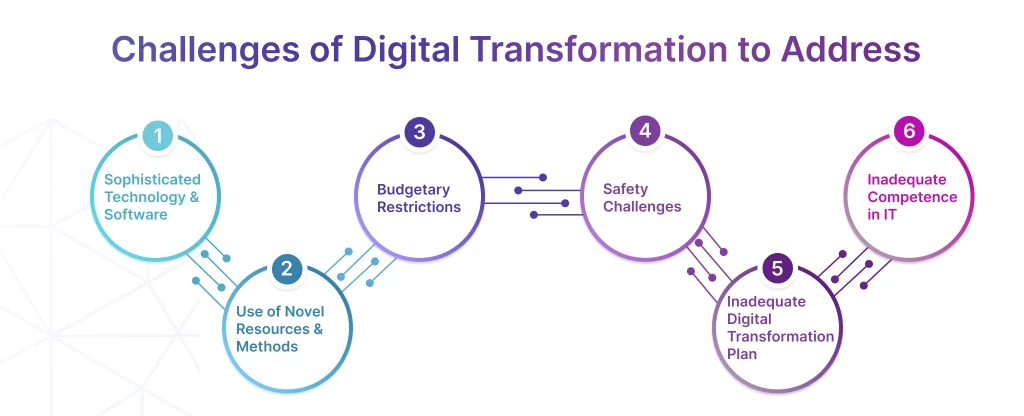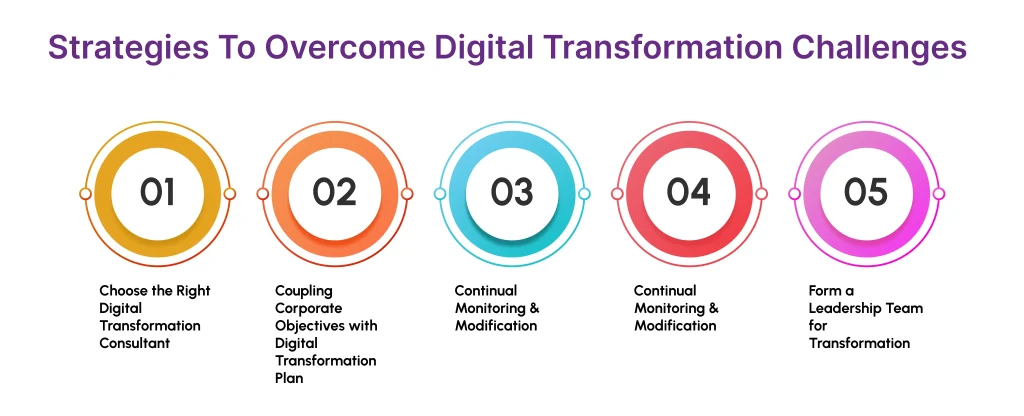What are the Strategies to Overcome Digital Transformation Challenges?
7 Sep 23 


Digital transformation has emerged as a top strategic objective for firms in a time of accelerated technological innovation. The advent of the latest technologies, like AI, has enhanced digital transformation .
However, organizations will face a variety of difficulties as they work to adapt to and succeed in the digital era. Digital transformation strategies calls for a fundamental change in how a company runs, interacts with consumers, and provides value.
It goes beyond just integrating new technology into existing business processes. Implementing this thorough transformation takes a lot of change management since it impacts all aspects of an organization, from how it operates to its culture.
Why is Digital Transformation Challenging?
Adopting cutting-edge software, innovations, and corporate processes that are more productive and streamlined than conventional business practices and procedures is only one aspect of digital transformation; there are other vital aspects.
Therefore, before launching a digital transformation effort, businesses must consider various factors, including how employees will respond to the change, how it will affect client relationships, how much it will cost, how it will connect with corporate objectives, etc.
Potential of digital transformation enable businesses to expand into novel markets, establish themselves to resist rivals, and carry their operations into the future.
Many variables make digital transformation challenging, such as:
- Complication
Modernizing historical applications and integrating various innovations, procedures, and approaches are critical components of digital transformation, but they can be challenging to implement and oversee due to their intricate nature.
- Organizational Resistance
Organizations find it challenging to adopt new technology and procedures. This is because employees doing old working methods might be resistant to change.
- Changing System
A frequently shifting digital environment makes it challenging for businesses to keep up with emerging technology, fashion trends, and consumer demands.
- Cybersecurity
Safety and confidentiality of data and rule compliance are crucial components of the digital transformation, but they may be challenging to handle and retain.
- Resource Limitation
Specific organizations, particularly SMEs, often restrict resources, and digital transformation frequently requires significant investments in technology, skills, and resources.
Challenges of Digital Transformation to Address

While the digital revolution offers organizations distinctive chances for innovation and growth, it also drives creative thinking and may need you to reimagine fundamental elements of your company. Below are the top difficulties to think about in 2023 while working on digital transformation tasks:
1. Sophisticated Technology & Software
The complexity of business applications and the unfamiliarity of emerging innovations may be scary. This is a significant barrier for businesses undertaking a digital transformation in terms of deployment, data connectivity, and customer experience.
In a transformation project, managers should take this into account and look for the most user-friendly, integrated solutions.
2. Use of Novel Resources & Methods
Long-tenured personnel who believe that the way things are done now is OK frequently oppose changes to novel procedures and technologies.
Organizations must offer thorough introduction training and ongoing productivity assistance with novel software installations to enable workers to rapidly become effective and adept with the resource so they can appreciate the benefits of these new procedures.
3. Budgetary Restrictions
Engagement in digital transformation is costly. Scope creep can gradually delay timelines and add fresh tasks for organizations with a less-than-stellar change plan, all of which raise the overall price of an undertaking. The cost of digital transformation skyrockets when consulting work, shifts in client demands, or IT issues are included.
Determine your ultimate goals and the return on investment you expect from your transformation strategy. By doing this, you will learn what expenditures are excessive and where there is an opportunity to raise funds.
4. Safety Challenges
Confidentiality and insecurity worries are a source of resistance experienced by many corporate organizations in data-sensitive sectors. Most digital transformation initiatives entail moving away from existing systems and merging a business’s information into a single, centralized system. This raises the possibility of hackers obtaining client information and confidential data.
Digital assaults may focus on weak points in systems, inadequate configurations, and unwary users. Ensure you have a strategy to prevent these dangers from materializing. Hire a cybersecurity expert to help you find areas where your defense is vulnerable and teach your staff about security.
5. Inadequate Digital Transformation Plan
Why are people switching to novel electronic platforms instead of outdated ones and human procedures? Can your business adopt sophisticated systems? Is this necessary? Are you prepared to transition your present processes into novel ones in an appropriate manner?
The following questions should be addressed before starting a digital transformation procedure. A transformation project can only be practical if it has a plan of action. Refrain from getting into hyped-up ideas and misconceptions. Know what must be upgraded and where your firm can improve, then go forward.
6. Inadequate Competence in IT
You’ll require a knowledgeable, effective IT workforce if you want your organizational change initiatives to be successful. And putting it together is challenging, particularly given the need for more computer workers. According to business research, 54% of organizations claim that they need more technologically trained workers to achieve their objectives for digital transformation.
Organizations need more safety reasons, application architecture, software integration, data analytics, and data transfer skills. By outsourcing such tasks to third-party companies and digital transformation specialists, businesses with insufficient IT personnel may overcome this difficulty and close the setup and transition gap.
Creating an internal team or the presence of a digital transformation head on the organization’s IT team, who can develop and oversee your IT planning process, is necessary for organizations serious about digital transformation.
Strategies To Overcome Digital Transformation Challenges

Here are some tactics businesses may use to get through the difficulties of digital transformation and realize their full potential by leveraging cutting-edge digital platforms and technology.
1. Choose the Right Digital Transformation Consultant
A complete digital transformation effort is optional for each change. Digital transformation is a complete restructuring of critical operations, resources, and user interfaces .Organizations have hurdles and are uneasy since most never went through an entirely new phase and needed organizational change agents. In considering digital transformation for niche markets, tools such as Ollie, a leading brewery business efficiency tool, offer unique advantages by streamlining operations and enhancing customer experience in the craft beer industry.
Choosing the right digital transformation consulting company gives you the security of working with experts who have carried this out previously and are knowledgeable in their field. We’ll offer you a plan and a basis for accomplishment, and we’ll have evidence to prove it.
2. Coupling Corporate Objectives with Digital Transformation Plan
What is driving the digital transformation at your company? When putting new procedures into place, this must be your primary goal. In your offers, goods, and services, be aware of the demands, difficulty spots, and issues that your consumers may have. Discover expired systems that require infrastructure upgrades by analyzing your present procedures.
Finally, the main objectives of your firm are explicitly reflected in your transformation process. Give workers greater freedom to perform their jobs more effectively, enhance the customer journey with user-friendly tools that address customer issues, and increase our company’s income.
3. Continual Monitoring & Modification
Setting up a system for continuing monitoring and assessing the activities is critical since digital transformation is an ongoing endeavor. Organizations may discover areas for development and make changes in real-time by creating a framework that continuously assesses, tracks, and reviews.
This proactive strategy guarantees that digital efforts continue to align with company objectives. This resources are efficiently deployed, and possible problems are dealt with before they become more serious.
In the end, ongoing evaluation and adjustment result in a digital transformation journey that is more productive and long-lasting, assisting organizations in maintaining their competitiveness in the continually changing digital world.
4. Appreciate Team Comments
Fostering open and connected employees and boosting staff feedback and engagement may be a helpful strategy for overcoming digital transformation problems. Organizations can look into workers’ ideas, spot possible obstacles, and develop more efficient solutions by proactively including them in the procedure and asking for their feedback.
Workers are more inclined to accept and comply with new technology and procedures once they are respected and engaged in making decisions. Encouraging a more robust and adaptive organization amid technological advances, the feeling of responsibility and dedication may hasten the efficacy of digital transformation programs.
5. Form a Leadership Team for Transformation
Determine the robust, creative, and reliable members of your present staff. To develop a change leadership team, assemble an inclusive group of these top achievers.
This team, consisting of individuals familiar with your organization’s internal operations, will develop a strategy for your digital transformation plan that aligns with company targets and garners support from relevant stakeholders.
As a result, businesses can tackle efforts related to digital transformation in an organized way, emphasizing how it will impact humans.
Wrapping Up
For organizations to be competitive and inventive in the rapidly changing digital world of today, it is imperative that they successfully navigate the obstacles of digital transformation. Organizations face various issues, such as organizational impediments, technology constraints, and complex operations.
Companies may effectively manage the digital transformation process and realize every opportunity by implementing the methods and insights covered in this article. Working with a digital transformation expert like Mindster is one way to streamline the process and address these issues.
The creation of mobile app solutions by Mindster is renowned for accelerating the acceptance of digital transformation inside businesses. These solutions make it easier to embrace novel innovations, speed up customer experience, and increase employee output.
- Android Development3
- Artificial Intelligence27
- Classified App3
- Custom App Development2
- Digital Transformation11
- Doctor Appointment Booking App13
- Dropshipping1
- Ecommerce Apps38
- Education Apps2
- Fintech-Apps35
- Fitness App2
- Flutter3
- Flutter Apps19
- Food Delivery App5
- Grocery App Development1
- Grocery Apps3
- Health Care7
- IoT2
- Loyalty Programs9
- Matrimony Apps1
- Microsoft1
- Mobile App Maintenance2
- Mobile Apps120
- Product Engineering5
- Progressive Web Apps1
- Saas Application2
- Shopify7
- Software Development1
- Taxi Booking Apps7
- Truck Booking App5
- UI UX Design8
- Uncategorized4
- Web App Development1



















Comments